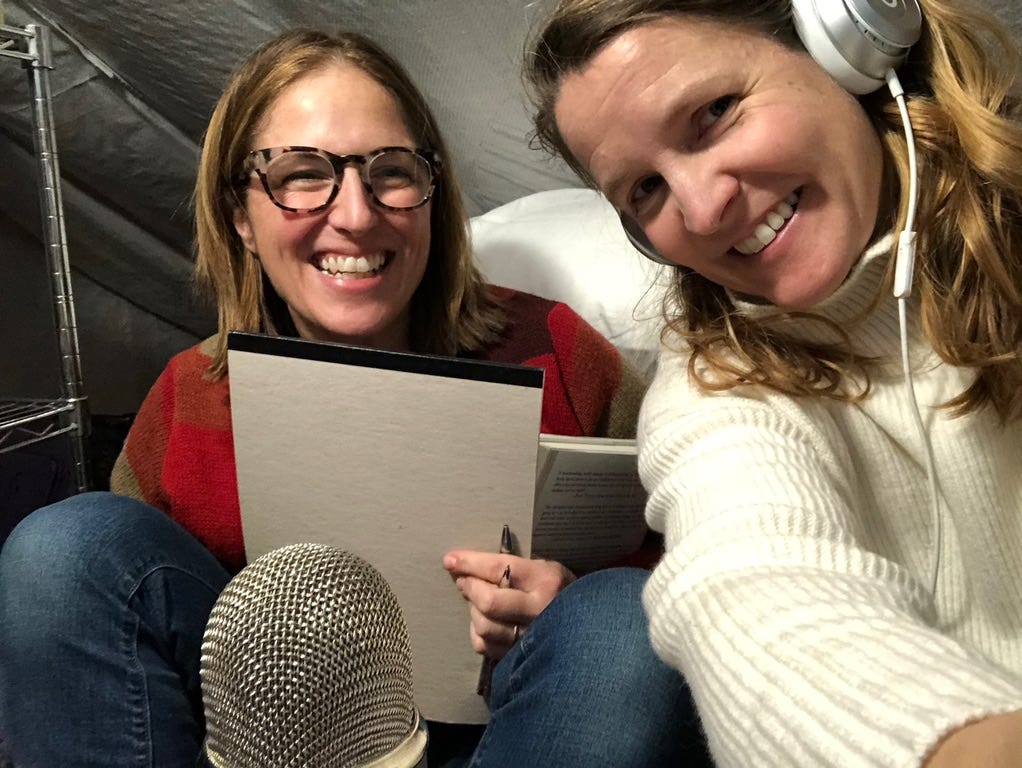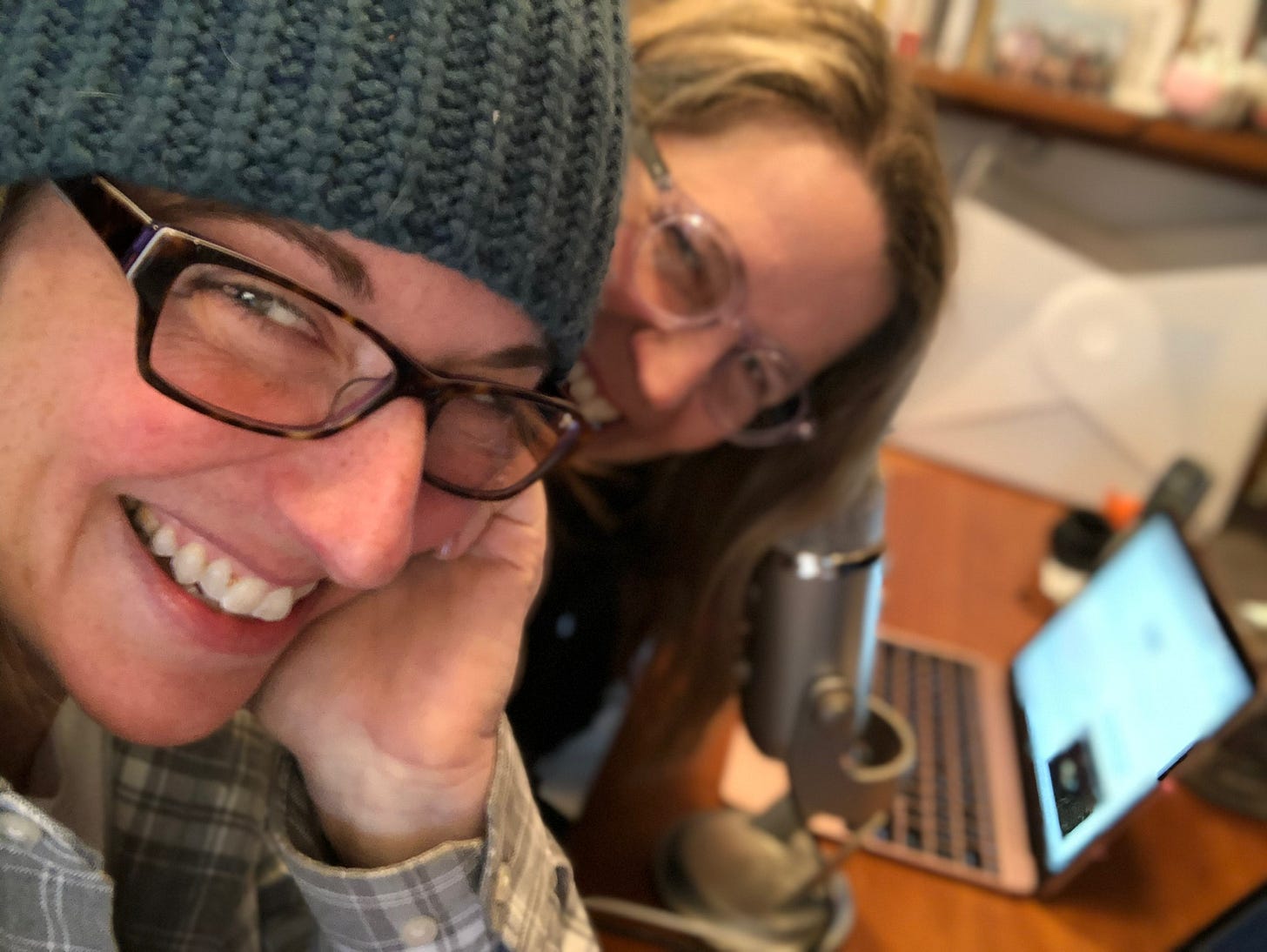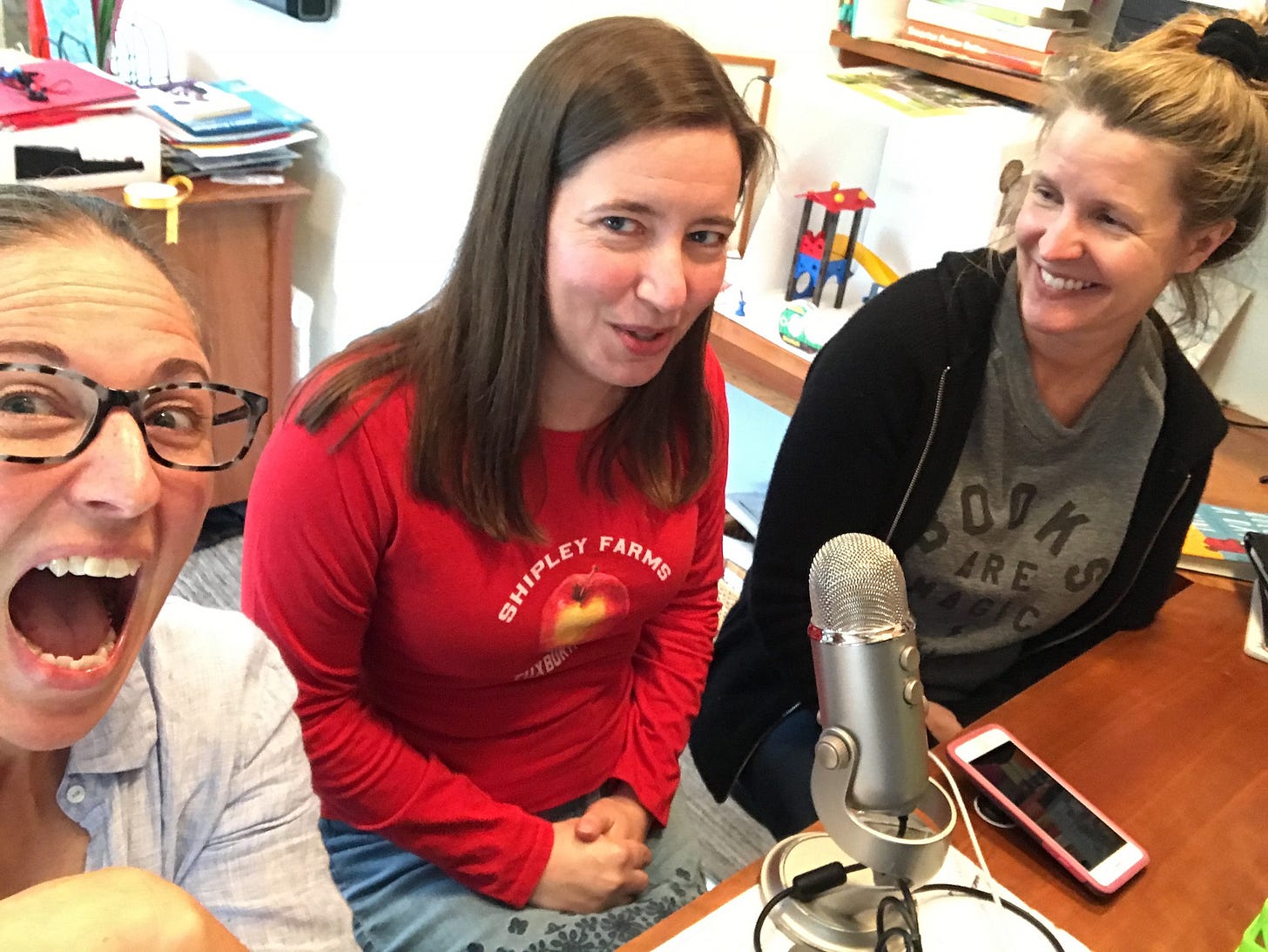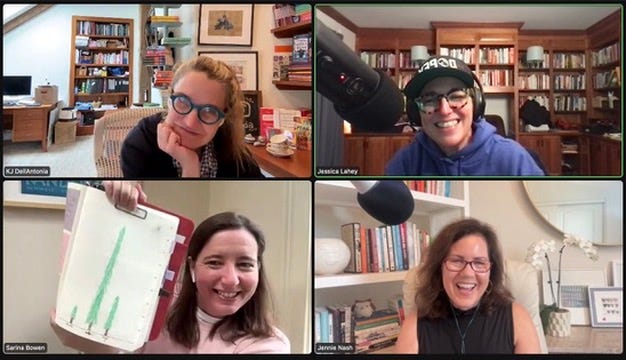
Hi all! Jess here, with a helpful (I hope) how-to for both my newsletter and the #AmWriting podcast. Apologies for the duplicate content if you subscribe to both (but yay you for subscribing to both, I LOVE YOU!)
When KJ Dell’Antonia and I started the #AmWriting podcast in 2016 (read: when KJ texted, “Enough talking, we are doing this podcast thing. It’s called #AmWriting. We record on Tuesday at 11.”) we knew approximately nothing about good podcasting practices. In retrospect, though I’d been a guest on hundreds of podcasts buy that time, I hardly understood good podcast guest practices. Now, after almost a decade of interviewing and being interviewed, it’s become clear these five things are not just good podcast guest protocol, they are bare minimums if you want the interview to go well. I’m keeping the tech talk to the bare minimum, I promise. Don’t get nervous. Breathe. I will walk you though each tip and explain why each is important.
I will also discuss random, irritating tech snafus that can happen under some very specific circumstances you may never run into at the end of this post.
Headphones.
Microphone.
Record your own source audio.
Recording location.
Dry run if you’ve never used the platform.
Headphones
Headphones are mandatory. If you are being interviewed via the most popular podcasting platforms (in my experience Zoom, Riverside, or Squadcast, we use Zoom for #AmWriting) both your voice and the voice(s) of the host will be audible in whatever space you have chosen to record (I mean this literally: your office, a closet, your kitchen, whatever). Your voice will be audible to the microphone (yay!) AND the voice of the person interviewing you will be audible (boooooooo!) via your computer speakers. The voice of the person(s) interviewing you coming out of your computer’s speaker will….well, put simply, mess with the audio of the source audio going INTO the microphone on the other end of the interview and the producer will mutter swears under his/her/their voice while they edit the interview. You know how sometimes back when we used landlines sometimes we’d hear our own voice in delay AND the voice of the person on the other end? That echo is what happens when you don’t use headphones on a podcast.
Now, when you wear headphones, (and use a microphone) these “accessories” or “sources” can mess with the way your computer interacts with Zoom, Riverside, Squadcast, or whatever platform is being used and/or your computer’s input/output settings. Don’t get nervous, I will discuss this issue we talk microphones and according to #5, you will be practicing ahead of time and know how to handle this snafu-rich situation.

Microphone
Yes, I know, it may seem silly to purchase a microphone just for interviews, but if you want to become a regular guest on podcasts, it’s a bare minimum purchase. Your laptop mic sucks. It just does. Think of this as a technical and PR tip. You sound better on a mic (especially once we deal with #3), and you LOOK more professional, as if you have invested real thought and money into being a good podcast guest.
There are tons of microphones to choose from and plenty of outlets that test them including my go-to testing source, Wirecutter. They tested USB microphones (mics that plug into your computer’s USB or USB-C port) Riverside has a similar resource. I don’t care where you get it, just choose a mic and learn how to use it. The cheapest, bare-bones and perfectly sufficient Wirecutter microphone recommendation starts at $25.00.
Once you plug your mic in and get your computer to recognize your it, you will have to make sure the computer knows to use it for your interview, no matter what platform the podcast wants you to use. The best way to ensure your input (the microphone) and output (headphones) are all set is to log on a few minutes early and do the “test your audio and video” prompt that usually pops up when you first log on to the platform but before you actually enter the “studio.” If you log on early, you can get in and do this test even if your host has not logged in yet.
If you seem to be all good on the test, but no one can hear you in the virtual studio, it’s likely because you are muted. Easy peasy fix. Click on the microphone icon in the bottom left of the screen (Zoom) that likely has a red line through it. Ditto if they can’t see you, click on the video icon that likely has a red line through it. Sometimes all can be great in the test, but if your Zoom or whatever platform settings are set to hide your video and audio when you enter the studio, you might be muted or need to enable your camera anyway.
Once you have a mic, adhere to these rules:
Don’t bump the mic
Try to keep a consistent (close) distance from the mic
Don’t put ice in your drink (it makes noise when you drink, duh)
Don’t eat or have a lozenge rolling around in your mouth (stuff it in your cheek)
If you have paper notes on the desk, don’t rustle them around
Don’t type on your computer while talking, use a pencil/pen if you need to take notes and limit your panicked internet searching for answers to questions you don’t know the answers to
Sit up and lean forward, it really does make you sound more alert and energized
Record your source audio
This is the most technically complicated of all the bare minimum podcast proficiency rules but it’s also the most important if you’d like to be considered a pro. I recommend it even though it’s a rule that will likely be obsolete soon. Yes, Zoom and Riverside and Squadcast and all the other platforms record the interview audio, but here’s the thing: your source audio will be better than the platform’s recording and some podcast producers value this source audio above the platform’s audio. As the platforms improve their recording quality, this will change, and this tip will likely become obsolete, but for now, knowing how to record your source audio is important. We ask our guests to record their source audio for our podcast, and as a frequent podcast guest, I have saved a couple of episodes by having my source audio on hand when a producer emailed to tell me their audio file was corrupted or deleted or whatever.
All you have to do use Quicktime (standard on any Mac) or Garage Band (lots of people hate it but I use it because it’s just THERE, already installed on my computer, easy to use and I can export into a format my producer likes). Now, Quicktime does this insanely stupid thing which is the record button is RED before you hit record and GREYED OUT when it’s actually recording. Look to make sure you are recording and look for the little audio wave line to move and make what looks like the EKG of a person in a serious cardiac situation. A recent guest thought she was recording when she was not because the button was red on Quicktime. Don’t be fooled. Also, both Quicktime and Garage band record to weird-ass locations on your computer. Tell it where to save the file so you know where to find it.
Consider your recording location
Does your office have a bare floor and walls? Is a fan or air conditioner running? Will it get too hot if you turn that fan or air conditioner off? Will your dogs be able to see squirrels or the UPS truck outside the window and freak out as a result? Do you have a clock that runs on a pendulum in the room that ticks and tocks? Does your dog snore?
An ideal location has carpeting, sound-dampening items on the walls (bookshelves with books on them are sound dampening!), a door that closes and no loud fans.
If your room is echoey, drape blankets and pillows around your desk area. It does help. Closets can be godsends in a pinch. We have recorded many episodes in hotel closets.
Dry run
I hope by now it’s obvious why a dry run can be a lifesaver. If you have access to the podcasting platform, ask to log on with a friend or family member to make sure your tech works. Yes, it’s a pain, but it could save your interview.
Finally, even for those of us who have been doing interviews for years, new snafus happen all the time as tech changes and software updates and we move and buy new computers and discover we have not downloaded the right version of the right software. That’s what dry runs are for and that’s also why we hardly ever fault our guests for tech snafus.
Here’s my pre-interview routine, and my dogs have learned it and know what’s what. About five to ten mintues before the podcast appointment, se all head into the office (unless there’s someone reliable around to do dog management). I check my email to make sure I know I have the interview link. I close my windows and blinds so squirrels are no longer visible and UPS trucks are no longer audible. I long ago ditched my doorbell but sometimes I post a “Recording in process, do not knock” sign on my house’s main door. I get some paper and a pen and make sure my phone is off or its bluetooth is off. I let any family at home know I’m podcasting, close my office door, close the noise-dampening curtains I’ve hung over my office door, and put my bluetooth earbuds in their charging case. I log on to the indicated platform via the link the host or their producer has sent me at least four minutes early in case my computer decides I must do a software update NOW and to check my audio and video connections. I open Garage Band or Quicktime and start recording my source audio, then save that audio file somewhere I can find it after the podcast is over. I take a deep breath, check for bedhead in the video window, and smile.
One super-specific thing I did that’s helped a lot as a podcaster who owns dogs: I created an account at UPS and FedEx and signed up for alerts and now I know when my UPS driver is about to arrive (usually within the next 5-10 minutes or so). It’s saved me not only when I’m podcasting but when I’m outside with the dogs and don’t want them to rush the dog or the driver. I mention this because it literally JUST happened here. I was typing this out, the dog was outside, and I got an alert that a FedEx delivery was about to happen. I had time to get the dogs inside and made the delivery easier and less stressful for the driver.
Other weird situations can happen, and here’s a few I’ve had to learn how to avoid the hard way:
If you use bluetooth earbuds lying around or in your pocket, put them in their case. You can bump them during the interview and cause your computer to say, “Oh! You want me to connect to your earbuds and ignore the headphones you worked so hard to get connected? Sure!” and suddenly your audio is connected to an earbud and you can no longer hear the person interviewing you. If this happens, go the icon that looks like earbuds or the little sound icon at the top of your computer screen, click on it, and when the popup menu comes up, re-select the headphones. That said, prevent this from happening in the first place by putting them away, in their charging case.
If someone calls you during the interview, the phone can commander your audio. There are lots of reasons this can happen depending on your tech, but I simply turn my phone off altogether or, if I need my phone to search things I’ve forgotten such as the author of the book I want to recommend, turn bluetooth off on your phone for the duration of the interview. Airplane mode might work, but I usually just turn the bluetooth off.
If you have a cat and use a bluetooth keyboard or mouse/trackpad and that cat jumps up on the desk and clicks things, they can send email drafts out or turn off your sound or turn UP your sound until it deafens you. Ask me how I know. I disable those two items if they are connected to my laptop/computer before I log on to an interview.
If you use a woodstove, don’t dump your hot ashes on the compost pile because your backyard could catch on fire and the fire chief might arrive at your house to cite your for burning without a permit while you are live on the radio. But this might be specific to me.
I have to head off to do a podcast interview in ten minutes, so I will end here. Yes, there is so much more to talk about, and maybe I will do a higher-level part II another time, but this will definitely get you started in the right direction.
Above all else, have fun, own your expertise, and banish that imposter syndrome because podcast invited YOU to be on the show. If they’d wanted some other, more famous, more lauded, more platformed person, they would have invited THEM. But they invited you. Be you.





Jessica, valuable information for me right now. I’m publishing my memoir in September and will start pitching podcasts soon. Even though I know KJ from Jennie Nash’s Bangor, Maine, retreat, and I have a memoir about perseverance, art, healing, and horses, I doubt I’ll ever appear on your podcast. But it would be lovely and fun. I love listening and learning from your show. Keep up the good work. You are appreciated. And thanks for all the great guest info and tech cautions.